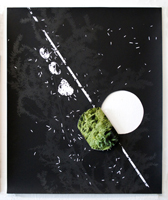“I’m more interested in asking the question than answering it,” says curator Carol Squiers, who organized “What Is a Photograph?,” opening today at New York’s International Center of Photography. Squiers is walking around the ICP’s downstairs galleries as young men on ladders install the final works in the 21-artist survey. In a corner sit two sculptural-looking pieces by American artist Marlo Pascual. Each includes a chromogenic print as the base for three-dimensional objects. In Untitled (2010), an old-fashioned studio portrait rendered in sherbet hues is speared by a fluorescent tube resting on a large rock. Yet for photo traditionalists, Pascual’s hybrid creations might be considered some of the more conventional contributions on view.
In fact, many of the pieces in “What Is a Photograph?” were produced without a camera. Alison Rossiter’s moody abstractions, for example, are the outcome of simply processing expired film paper. In Russian USSR (Siberia), Rossiter took the Soviet stock she purchased off the Internet (it expired in 1957, untouched) and submerged it in developer. The shadowy configuration that surfaced in 2009 reveals the paper’s past life–decades spent, perhaps, on a dusty shelf in Novosibirsk. Rossiter more directly intervened with Fuji gaslight, expired film from the 1920s, by pouring chemicals onto the paper to painterly, erotic effect; the resulting negative space suggests a woman’s parted legs.
Obsolescence is a recurrent theme for the contemporary photographers included in the exhibit, as 20th-century tools began to disappear with the rise of digital technology in the 1990s. For artists still interested in analog photography, the scarcity of, say, Kodachrome film has pushed them into new territory. “Because a lot of analog materials are no longer being manufactured, I saw a lot of people [making] a kind of last-ditch effort to use a medium that they’ve worked with for a long time and love,” explains Squiers. “But it just seemed to inspire this great burst of more experimental photography.” This current phenomenon, when considered alongside earlier Conceptual art made in the seventies and eighties, such as Sigmar Polke and Gerhard Richter’s painted photographs, proposes “an explosion of photographic activity,” says Squiers of the exhibit.
Not everyone is resisting Photoshop, however. Computer manipulation plays a prominent role in the work of 27-year-old Travess Smalley, who assembles collages onto a scanner bed, then toys with the shapes further on-screen. His pigment print Capture Physical Presence #7 holds all the playfulness of a Matisse decoupage, while the planetary forms and Hypercolor shades in another composition conjure the primitive graphics of early MTV. A similarly galactic motif appears in Letha Wilson’s gelatin silver Photogram New York (Nova Scotia) and again in David Benjamin Sherry’s untitled teal tableau, textured with sand and evoking the pocked surface of Mars.
Testing the bounds of the medium, the most far-out of Squiers’s selections are the “durational photographs” by Canadian artist Owen Kydd. Mounted on display screens, these looped videos are framed like a conventional photographic object, but the images on view evolve moment by moment, as in Pico Boulevard (Nocturne), where the light refracted onto bric-a-brac in a storefront window changes with every passing car. As for where photography is headed next, Squiers sees it going “in a million different directions,” some of which, she adds, “artists are in the process of dreaming up right now.”
“What Is a Photograph?” is on view at the International Center of Photography in New York from January 31 through May 4, 2014; icp.org

